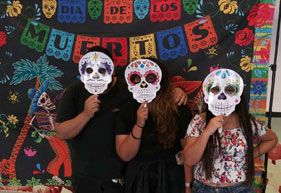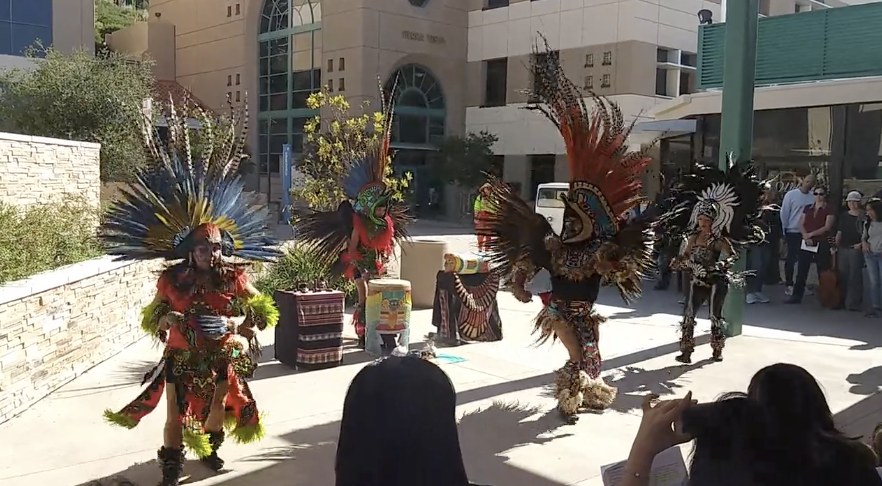
Día de los Muertos
Día De Los Muertos is a day of observance to acknowledge death as a part of life and celebrate those who have passed. It is a day to welcome the spirits of loved ones as honored guests. This is a family-centered day where the spirits visit the living and the living celebrate them in remembrance. This is a contrast from the European and American individualistic attitude of death and personal identity, where death is often viewed as something to fear or as an end (Marchi, 2009). The worldview of many Indigenous communities in Mexico and Latin American countries is very community-focused and hold a collective attitude. Historically, and culturally, this has been crucial to the physical and psychological survival of these communities and this day of observance demonstrates that value of community (Marchi, 2009).
At the center of Día De Los Muertos, are offrendas, or offerings that families create in their homes or over the loved one’s graves (Marchi, 2009). These “home shrines” may include the loved one’s favorite drinks and food, candles, and personal mementos of the dead (Marchi, 2009). Papel picado or cut tissue paper, calaveras de azucar or sugar skulls, pan de muerto or bread of the dead, incense, tamales, fruit, nuts, and candies can be seen throughout altars or in the offerings. On the day that the angelitos or little angels, are celebrated, the child’s favorite dish may be made. Candies and decorations of toys will also be evident. On the day that adult souls are celebrated, the food, altars and beverages change in their remembrance (Hocker et. al., 2005). There is even a day to celebrate our pet’s souls.
Although predominant in Mexico, this special day is also celebrated across many countries including those of Ecuador, Guatemala, Bolivia, Haiti, and Peru to name a few (Hocker et. al., 2005). Día De Los Muertos is celebrated on November 1st, and ends on November 2nd. However, the ofrendas, or offerings, are put out in remembrance as early as October 25th (Marchi, 2009). The spirits of the children are expected to arrive before adults on October 31st while adult souls arrive on November 1st (Hocker et. al., 2005). On November 2nd, families take part of the food to the cemeteries, graves are decorated with cempasúchil or marigold flowers, coxcomb flowers, and white gladioli flowers. The vigils can last all night (Hocker et. al., 2005). The tradition carries on to the dawn, where then, the dead return to their world. It is important to note that although traditionally recognized in Mexico, each country has their own cultural way of celebrating. This can be noticed in the types of food, offerings, and even the beginning days of celebration. It may even vary be region to region. (Marchi, 2009). Nonetheless, all of these traditions demonstrate how life is and death are a cycle of life, both to be celebrated and not feared.

Background and History
The celebration of the dead and the traditions between both worlds can be traced back to the days of the Aztecs, Maya, Mixtec, Aymara, and Quecha (Marchi, 2009). There is evidence that indigenous cultures of pre-Hispanic Mexico, recorded these practices through hieroglyphs picture, and symbols (Marchi, 2009). These traditions were core beliefs long before the arrival of Europeans to the Americas, and before the Spanish invaded Mexico. Fast forward to today, Día De Los Muertos is a fusion of indigenous and Roman Catholic rituals honoring the dead (Marchi, 2009). This Roman Catholicism invasion in Mexico pushed an effort to eradicate all indigenous traditions and culture. However, the Catholic Missionaries found it difficult to eradicate all practices including the ones of honoring the dead (Marchi, 2009). The Roman Catholic All Saints Day consisted of viewing death as a time of suffering, a need to free the souls, and some celebratory events for the saints that were celebrated on November 1st and 2nd; a perspective different than the indigenous people. (Marchi, 2009).
As a result of their failed eradication in this practice, Roman Catholic liturgical relocated their efforts to fuse the celebration of Indigenous customs honoring the dead, with Catholicism’s specific dates of “All Saints’ Day” and their “All Souls Day” (Marchi, 2009). It is why Día De Los Muertos falls on these days today. The result is the mixture of indigenous practices that emphasize death as an important part of life, as well as Catholic practices. A beautiful indigenous practice while also, deeply enwoven, the evidence of exploitation and eradication of people.
Today, many of these practices to honor the dead, remain the same. The practices, the values of family, and death as a part of life are evident throughout Mexico and Latin American practices. The holiday here in the United States holds very similar traditions with a few differences. Again, this is diverse region by region. In the United States. Some of the reasons that here in the United States the practices of Día De Los Muertos may not include all indigenous practices are: the pressure that many Mexican Americans and Latino Americans have faced to assimilate to Anglo-cultural norms, not visiting graves on November 2nd because many migrants do not have relatives buried nearby, and the for profit practices evident in the United States to make money out of Día De Los Muertos (Marchi, 2009).
Remembering the dead and celebrating them is something sacred for many who celebrate Día De Los Muertos. There is a core value placed on community and culture. Regardless of the region or way practiced, Día De Los Muertos is growing in the United States and has created an awareness of this special day. It is a reminder that our loved ones who have passed away are present in spirit and in our memories. That is something worthy to celebrate.
Curated by Fidel Gonzalez, Adjunct Counselor for Student Equity
Sources
Hocker, B. Orantes, E., Henry, B., Davidman, R., Nelson, Karen. (2005). Días De Los Muertos Curriculum Packet. Oakland Museum of California.
Marchi, R. M. (2009). Day of the Dead in the USA : The Migration and Transformation of a Cultural Phenomenon. Rutgers University Press.
